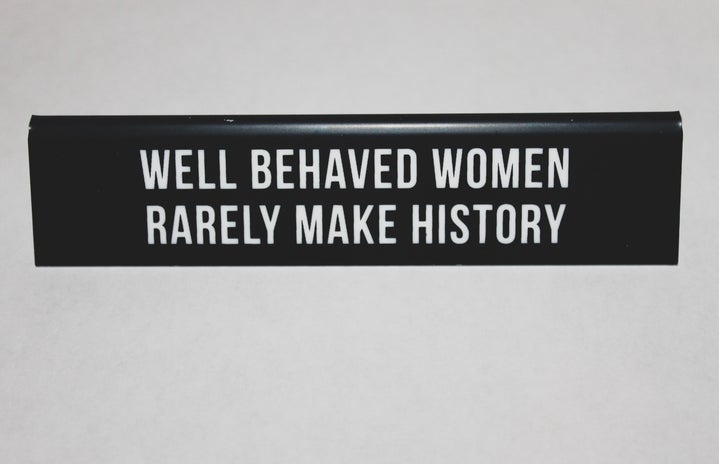Now, here’s the thing: I adore hokey sci-fi. So when a friend suggested watching Star Trek to me, I realized I will be falling into a Captain Kirk sized hole of binge-watching over my first semester at Kenyon. However, the whole time, I couldn’t help being troubled by the way they portrayed the three female characters in this episode. Having multiple female characters on a show is great, but not when their only purpose of fawning all over the semi-hunky Captain Pike. I started thinking about the unrealistic and problematic portrayals of women in sci-fi television and film.
Let’s start off with what spurred me to write this whole shebang. So some casual Star Trek fans may not know that the episode “Where No Man Has Gone Before” is not the original pilot episode of the show; NBC ordered it when they rejected the original pilot episode “The Cage.”
“The Cage” features the captain of the USS Enterprise—Christopher Pike, not James T. Kirk—and his team landing on a foreign planet after receiving a distress call from human survivors there. Once on the plant, Captain Pike meets a beautiful woman called Vina, who separates him from the group and takes him to the place that keeps up their health. However, Vina disintegrates into thin air and the Talosians—men with giant heads and horribly molded clay ears who created the illusion of the other survivors—take Pike captive. Pike learns the Talosians want him to build a life with the enslaved Vina in order to create a human family for the Talosians to study. When he refuses, the Talosians beam down the only two female members of Pike’s crew and tells him to “pick his Eve.” The four humans escape the Talosians, who agree to let them leave. However, Vina elects to stay because the crash of her ship on the planet disfigured her face and the Talosians keep up her illusion of beauty.
There are a lot of issues with the episode concerning the objectification of women and implying women are completely subservient to me; however, my biggest issue with this episode is towards the end, when Pike, the Colt, and Number One are leaving the planet. Vina decides to stay because evidently, it is better to maintain your facade of beauty than you know, escape enslavement. (Is my sarcasm, not apparent?) Once back on the ship, Colt asks if Vina was coming and Pike says “No, I agreed with her reasons.” It pleases me you do, bud, because I don’t.
Now, of course, Star Trek has come a long way since then. Captain Kirk is a humongous feminist and respects the women on his crew fully. So yes, Star Trek made some important changes after the fumbly, prejudiced mistakes in the original pilot. However, the rest of the sci-fi isn’t always on the same page.
Take for example the tragedy of Bella Swan in the Twilight books and movies. I understand people will disagree with the inclusion of vampires in science fiction, but just bare with me for a second. Bella Swan represents perhaps the worst written female character written by another woman. Unlike the hypersexualized heroines created only for the purpose of putting boobs on screen, Bella Swan has almost the opposite effect: she is so bland and so flat that her only purpose is to be subservient to the male characters in the novel. And it is a tragedy that so many young women my age grew up with her as a role model. For every Hermione Granger and Katniss Everdeen, we have a Bella Swan.
But let’s take Katniss Everdeen for a second. In the novels, Katniss is a strong female character fighting for her life and to bring pride to her family and impoverished community. Although there is a romantic subplot present in some of the later books, The Hunger Games primarily focuses on her inner strength and knowledge. However, in the movie series, they bastardize Katniss’ strength as a woman and uses it as a tool to impress her two suitors, Peeta and Gale. The story becomes less about Katniss’ merits as a woman and more about the love triangle.
To take another example of how even modern movies can twist strong female representation into blatant misogyny, let’s discuss 2013’s Riddick. Riddick is a sequel to a movie titled Pitch Black, which has a kickass female character named Carolyn Fry. If you haven’t seen the film, you check out a short description at this link. However, what you need to know is how blatantly sexist it is against women. The mercenaries in the movie as constantly negative towards women, including an incredibly sexually inappropriate primary villain. Now, this could be a tool to turn the viewers against the antagonist, but it is so omnipresent in the film that I began to wonder what was a tool for characterization and what was misogyny on the part of the writers. According to Zoe Chevat’s article, Riddick Me This: What’s Sexism Got to Do With Monsters?, the constant rape threats in the movie “[communicate] to an audience…women should expect to be raped and threatened with rape” and “no matter how many skills or qualities you share with male heroes, the fact of your gender will always loom larger in the eyes of your opponents and cause them to think you are a sex toy.”
However, the larger issue with Riddick lies in the character Dahl—starting with the fact that her name sounds patronizingly like “doll.” Throughout the movie, almost all references to her are about her gender, including rape threats and overtly sexualized comments, even some said by Riddick himself. Oh, and even though Dahl states she is a lesbian, she still invites Riddick to bed. Because obviously all lesbians are waiting for is a bulky, strong killing machine to turn them hetero again. Hollywood turned a movie franchise that once featured an amazing, strong female into one that treats women like a commodity to laugh at.
And the extensions of disappointing female characters in sci-fi go on and on and on: Dualla on Battlestar Galactica who only existed to be a part of romantic sub-plots, but then was never hot enough to win the guy. Isabelle Tyler on The 4400 who decides to destroy the world because her boyfriend won’t have sex with her. Dawn on Buffy the Vampire Slayer who, for being the daughter of one of the badass women in TV history, was the constant damsel-in-distress. Maya on Heroes who fulfilled every Latin woman stereotype and then ran away to a convent to be a nun (because of course). Diana from The X-Files who wouldn’t have existed if Mulder didn’t need yet another ex-lover. And just so so so many more.
So yes, we need better writers to write better parts for more realistic women. That’s key. Part of this disparity is there are way, way more male writers in the science fiction genre (both literary and in Hollywood) than there are female writers. So step one: change how Hollywood has operated for the past 100 years. Easy.
The other issue derives from our societal attitudes in science fiction. People—see: men—freak out when the protagonist of a science fiction film is a female who is not scantily clad. There are so many examples of this, but let’s just use a case study of my favorite science fiction franchise: Star Wars. To start with the original series—there will be no discussion of the prequels because those aren’t real—Princess Leia? Total badass. Even though she falls in love with Han Solo, it is abundantly clear that Leia is here to kick butt, not take orders from men. However, ask any nerd fanboy about his favorite Princess Leia scene and you will hear a resounding chorus of “Slave Leia.” Yes, yes; even Star Wars isn’t a perfect feminist masterpiece because of the objectification of Leia in Return of the Jedi. Now, yes, we could argue the scantily-clad bikini costume serves to turn the audience against Jabba the Hut, but we all know it was a tool to glue eyeballs to the screen.
But more problematic than the adoration of “Slave Leia” in the original series is the reaction to the female characters in the new Star Wars franchise. Now, most people love Daisy Ridley’s portrayal of Rey in The Force Awakens. As a young girl, I played with lightsabers and wanted to be like the characters in the movies. So to see a lady kick bahootie with a lightsaber? Well, that was a dream come true. However, the misogynist fanboys reviled The Force Awakens for daring to feature a fully-clothed female character who didn’t have an overt love interest as the protagonist. The movie is about Rey, not about her relationship with Finn or her boobs. And the fanboys can’t handle it. And when Star Wars announced that Felicity Jones, another female, would be the protagonist of Rouge One? They revolted.
The male viewers of science fiction can’t handle strong female characters taking the positions of male characters. Just look at the vitriolic reaction to the all-female Ghostbusters. Even though (in my opinion) the movie turned out to be subpar, the fanboys were up in arms when the producers announced the very concept, before a cast or a script.
So yes, we need to improve the diversity writers of science fiction, so better writers can write better characters and the status of women in sci-fi will change. However, we also need to affect change in our culture. By showing the movie industry that we want female characters that offer more than just a pretty face, Hollywood will take note and push the trend towards fewer stereotypes and more dimensions. Hollywood reacts to money, so we need to put our money into Star Wars and not Riddick.
Live long and prosper.


